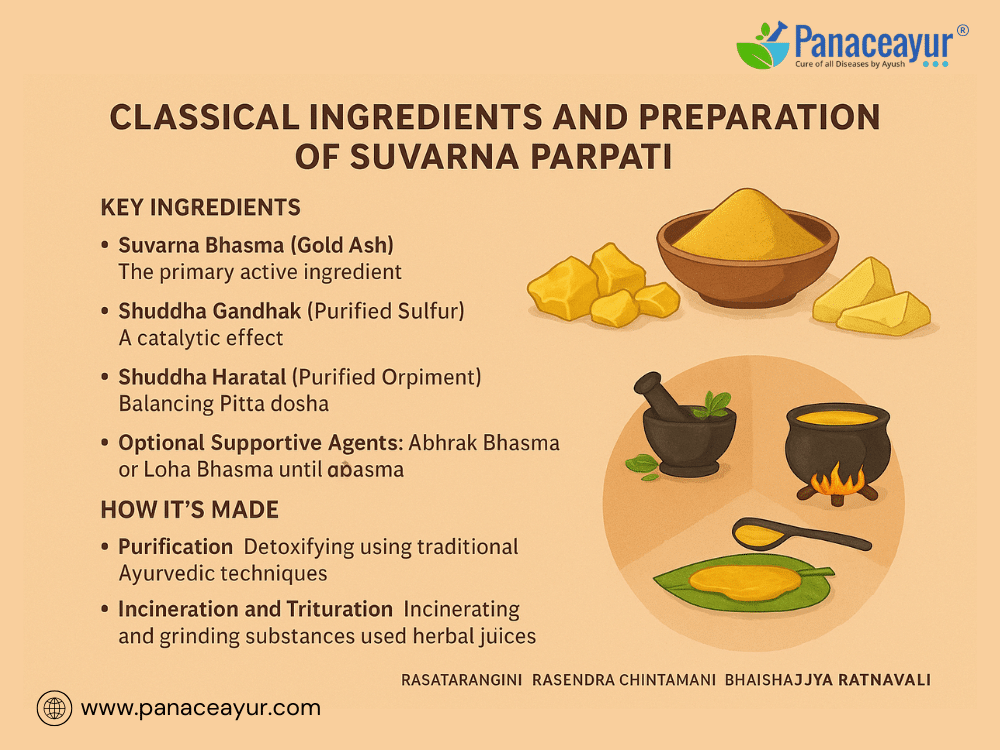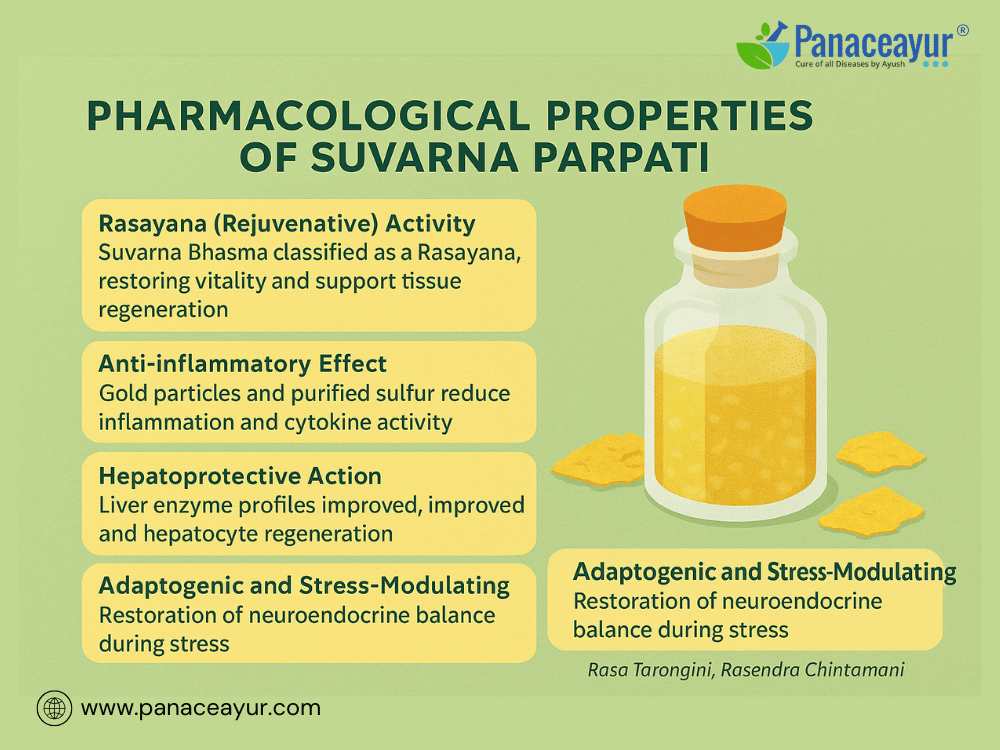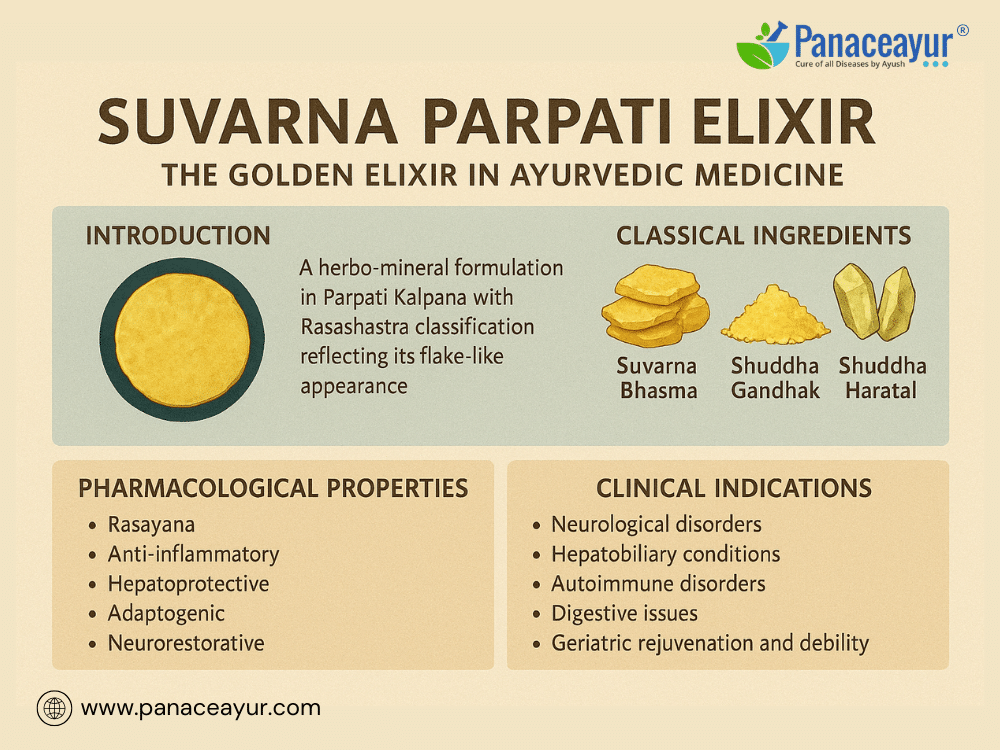- Classical Ingredients and Preparation
- Pharmacological Properties of Suvarna Parpati
- Modern Scientific Studies
- Clinical Indications (Usage)
- Dosage and Anupana (Adjuvants)
- Safety, Toxicity, and Standardization
- Comparative View: Suvarna Parpati vs. Other Suvarna Kalpas
- Contraindications and Precautions
- References
Suvarna Parpati, often referred to as the “golden melt” in Ayurvedic Rasashastra, is a herbo-mineral formulation rooted in the ancient science of Parpati Kalpana—a specialized class of medicines designed for enhanced assimilation and long-term therapeutic benefit. The word “Parpati” derives from the Sanskrit root ‘parpat’, meaning to spread or flake, reflecting its thin, flaky, disc-like appearance after preparation [1].
Unlike single-metal preparations like Suvarna Bhasma, Suvarna Parpati is a compound formulation combining gold ash (Suvarna Bhasma) with other purified minerals such as Gandhak (sulphur) and Haratal (orpiment). This synergistic blend makes it highly potent in rejuvenating tissues, correcting deep-seated metabolic imbalances, and fortifying immunity [2].
What makes Suvarna Parpati truly remarkable is its adaptability—it has been classically indicated for neurological disorders, chronic digestive issues, liver pathologies, and auto-immune dysfunctions, with individualized administration based on patient constitution (Prakriti) and disease stage [3]. It is part of a lineage of formulations developed by ancient Ayurvedic alchemists who believed in not just suppressing symptoms but revitalizing the body’s inner intelligence for self-healing.
Historically, this formulation was prescribed to kings and warriors during convalescence to restore lost vitality, enhance cognitive resilience, and support long life. Today, it is making a resurgence in integrative protocols, especially for patients seeking natural, long-term solutions to chronic and lifestyle-related diseases.
As a bridge between traditional Ayurvedic pharmacology and modern nanomedicine, Suvarna Parpati represents a fascinating example of how ancient medical wisdom anticipated biochemical principles now validated by scientific research [4].
Classical Ingredients and Preparation

Suvarna Parpati is a sophisticated Ayurvedic formulation crafted through a time-tested metallurgical process. It falls under the category of Rasashastra medicines, which use purified metals and minerals to create potent therapeutic compounds. The preparation method and ingredients are carefully selected to ensure safety, efficacy, and optimal absorption.
Key Ingredients
The classical formulation includes:
- Suvarna Bhasma (Gold Ash)
This is the primary active ingredient. Prepared from pure gold through a multi-step calcination process, Suvarna Bhasma is traditionally used to rejuvenate the body, support the immune system, and enhance cognitive function. - Shuddha Gandhak (Purified Sulfur)
Sulfur is included for its catalytic effect. It helps carry other substances deep into the body’s tissues and supports detoxification and anti-inflammatory actions. - Shuddha Haratal (Purified Orpiment)
A mineral compound processed to remove toxicity, Haratal is used in controlled quantities to balance Pitta dosha and assist in chronic digestive and metabolic conditions. - Optional Supportive Agents
In some traditional versions, ingredients like Abhrak Bhasma (mica) or Loha Bhasma (iron) may be added for organ-specific targeting.
How It’s Made
The preparation process is highly specialized and involves:
- Purification
All ingredients are detoxified using traditional Ayurvedic techniques such as Shodhana (purification with herbal media like cow’s urine or lemon juice). - Incineration and Trituration
The purified substances are incinerated at controlled temperatures and ground together using herbal juices in a process called Mardana. - Melting and Molding
The mixture is gently heated until it melts. It is then poured onto a smooth surface (traditionally banana leaf or clean metal) and allowed to cool. As it solidifies, it forms thin discs—known as Parpati—which are later broken and used as medicine.
Why This Form Matters
Parpati Kalpana offers several clinical advantages:
- Enhanced bioavailability
- Improved shelf stability
- Faster gastrointestinal absorption
- Lower risk of metallic toxicity when properly prepared
These qualities make Suvarna Parpati especially effective in chronic conditions where long-term tissue nourishment and systemic modulation are needed.
Pharmacological Properties of Suvarna Parpati

Suvarna Parpati exerts its therapeutic effects through a unique combination of metallic and mineral constituents that have undergone rigorous classical processing. This ensures bioavailability and biocompatibility while maximizing pharmacodynamic potential. Modern research supports many of its classical claims, especially in the domains of immunology, hepatology, and neurology.
1. Rasayana (Rejuvenative) Activity
Suvarna Bhasma, the core component, is categorized as a Rasayana in Ayurvedic medicine—agents that restore vitality, longevity, and systemic balance. Rasayana therapy has been shown to improve mitochondrial function, promote DNA repair, and enhance overall tissue regeneration [1].
2. Anti-inflammatory Effect
Purified sulfur (Gandhak) and gold particles in nanostructured form exhibit strong anti-inflammatory properties by modulating cytokine activity, suppressing pro-inflammatory gene expression, and inhibiting neutrophil migration [2]. This makes the formulation particularly effective in autoimmune and arthritic conditions [3].
3. Hepatoprotective Action
Experimental studies show that gold-based formulations improve liver enzyme profiles, reduce hepatic oxidative stress, and promote hepatocyte regeneration. This is in line with classical use of Suvarna Parpati in liver disorders such as hepatitis and cirrhosis [4].
4. Adaptogenic and Stress-Modulating
Suvarna Parpati helps restore neuroendocrine balance during stress by supporting adrenal and hypothalamic function. It regulates cortisol levels, improves mental focus, and supports recovery from fatigue and chronic burnout [5].
5. Neurorestorative Effects
Gold nanoparticles derived from Bhasma have demonstrated neuroregenerative potential in pre-clinical models. Suvarna Parpati is traditionally indicated for epilepsy, Parkinson’s disease, and post-stroke rehabilitation. Its components promote synaptic repair, neuronal longevity, and cerebral blood flow [6].
These actions are not only aligned with traditional Ayurvedic theory (Tridosha balance and Dhatu nourishment) but also corroborated by emerging biomedical data. The formulation’s multi-targeted mechanism makes it ideal for chronic and degenerative diseases requiring systemic modulation.
Modern Scientific Studies

Recent advances in pharmacological and nanomedicine research have validated several therapeutic properties attributed to Suvarna Parpati in classical Ayurvedic literature. While the formulation itself is rooted in ancient protocols, modern science is increasingly shedding light on its active mechanisms—especially those involving metallic nanoparticles.
Gold Nanoparticles and Cellular Healing
Suvarna Bhasma, the calcined gold ash in Suvarna Parpati, is rich in nano-sized particles. Studies using transmission electron microscopy (TEM) and X-ray diffraction (XRD) have confirmed the presence of gold nanoparticles ranging from 10–60 nm in size [1]. These particles have shown:
- High cellular compatibility
- Antioxidant potential
- Enhanced tissue penetration
Gold nanoparticles are known to stimulate cellular repair, mitochondrial energy production, and anti-apoptotic pathways in neural and hepatic tissues [2].
Immunomodulatory Action
Multiple pre-clinical studies have demonstrated that gold-based Bhasmas reduce levels of inflammatory cytokines like IL-6, TNF-α, and IL-1β, suggesting significant immune-regulating potential [3]. This aligns with Suvarna Parpati’s classical use in autoimmune diseases and chronic inflammatory conditions.
Hepatoprotective Evidence
Animal models of liver injury (induced by carbon tetrachloride or paracetamol toxicity) showed improved ALT, AST, and bilirubin levels after administration of gold-sulfur mineral preparations similar to Suvarna Parpati [4]. Histological analysis indicated reduced hepatic necrosis and enhanced regeneration of hepatocytes.
Neuroprotective and Cognitive Enhancing Effects
A recent 2020 study published in the Journal of Ethnopharmacology demonstrated that Suvarna Bhasma and its combinations improved memory retention and reduced oxidative stress markers in brain tissue of Alzheimer-induced rats [5]. These findings suggest potential for conditions like epilepsy, dementia, and age-related cognitive decline.
Anti-Cancer and DNA-Protective Role
Gold and sulfur-based Ayurvedic formulations are currently under investigation for their anti-proliferative and genoprotective effects. Early results show DNA repair enhancement and mitochondrial stabilization under oxidative stress [6].
While clinical trials are limited, the body of evidence from preclinical models and bio-nanotechnology strongly supports the rationale for Suvarna Parpati’s integrative use in chronic care protocols.
Clinical Indications (Usage)

Suvarna Parpati has a long history of use in Ayurvedic medicine for managing chronic, degenerative, and immune-compromised conditions. Its action is systemic, influencing multiple organ systems simultaneously. The following are its most widely indicated uses, as documented in classical texts and supported by emerging research.
1. Neurological Disorders
Suvarna Parpati is traditionally prescribed in conditions like epilepsy (Apasmara), Parkinsonism (Kampavata), and dementia. Its neurorestorative properties help improve synaptic connectivity, reduce tremors, and enhance memory retention [1]. Modern research attributes this to gold nanoparticle-mediated neurogenesis and antioxidant activity in brain tissues [2].
2. Hepatobiliary Conditions
This formulation is often used for chronic liver disorders, including hepatitis, early cirrhosis, fatty liver, and post-jaundice recovery. It enhances liver enzyme profiles and promotes hepatocyte regeneration, aligning with classical descriptions in Bhaishajya Ratnavali and Rasendra Chintamani [3].
3. Autoimmune and Inflammatory Diseases
Suvarna Parpati demonstrates significant benefit in rheumatoid arthritis, systemic lupus erythematosus (SLE), and psoriasis. It reduces inflammatory cytokine activity and modulates the immune response, a property attributed to both Suvarna Bhasma and Gandhak [4].
4. Chronic Digestive Disorders
It is commonly indicated in conditions such as irritable bowel syndrome (IBS), grahani, and intestinal malabsorption. The formulation improves Agni (digestive fire), strengthens gut mucosa, and reduces inflammation in the gut lining [5].
5. Geriatric Rejuvenation and General Debility
In older adults, Suvarna Parpati is used as a Rasayana for reversing fatigue, poor cognition, weak digestion, and low immunity. Its ability to support Ojas (vital essence) makes it ideal for enhancing longevity and vitality [6]. It is often co-administered with milk or ghee for Vata-predominant patients.
These clinical indications are always individualized based on Prakriti (body constitution), disease stage, and digestive capacity (Agni). When used under proper medical supervision, Suvarna Parpati offers a powerful integrative option for long-term disease reversal and systemic restoration.
Dosage and Anupana (Adjuvants)
Suvarna Parpati is a potent Rasayana formulation that requires careful administration. Its dosage and supporting agents (anupana) are customized according to the patient’s age, Prakriti (body constitution), disease condition, and digestive strength (Agni). When administered properly, it can deliver deep rejuvenative and organ-specific effects without causing toxicity.
Typical Dosage Range
The classical recommended dose varies from 62.5 mg to 125 mg, once or twice daily, depending on the indication and patient tolerance [1]. In cases of chronic or degenerative conditions, a graduated increase under physician supervision is sometimes advised.
Higher doses or long-term usage should only be initiated after Shodhana (purification) and Agni assessment, especially in individuals with weak digestion or Pitta-dominant constitution [2].
Common Anupanas (Adjuvants)
Anupanas help carry the formulation to the desired tissue systems and enhance its absorption. They also balance the Doshas and reduce potential aggravations.
- For Vata disorders: Cow’s ghee or warm milk
- For Pitta imbalance or liver disorders: Sugar candy water, Yashtimadhu decoction, or goat’s milk
- For Kapha or digestion-related issues: Honey with Trikatu churna (for short-term use only)
Anupana selection is based on classical Ayurvedic pairing principles, with the aim of increasing bioavailability and tissue targeting [3].
Form and Mode of Administration
Suvarna Parpati is generally administered:
- In flake form, directly ingested with adjuvant
- Crushed into powder, mixed with honey or ghee
- With food, especially during convalescence and geriatric care
Patients are usually advised to take it on an empty stomach or 30 minutes before meals, unless contraindicated.
Proper spacing with incompatible foods, daily monitoring, and periodic reassessment are essential to ensure safety and optimize outcomes. Self-administration without proper diagnosis and Ayurvedic guidance is not advised.
Safety, Toxicity, and Standardization
Suvarna Parpati is a herbo-mineral formulation that includes purified gold (Suvarna Bhasma), sulfur, and orpiment. While these ingredients may raise safety concerns in modern pharmacology, centuries of Ayurvedic practice—and recent scientific scrutiny—support its use when properly prepared and administered.
Safety When Properly Prepared
The safety of Suvarna Parpati hinges on two critical factors: purification (Shodhana) and incineration (Marana). These classical processes neutralize the inherent toxicity of heavy metals and convert them into bio-assimilable, stable forms. In multiple studies, Suvarna Bhasma has shown non-toxicity even in higher doses when traditionally processed.
Properly prepared Suvarna Parpati:
- Does not accumulate in tissues like synthetic heavy metal salts
- Passes through biotransformation pathways without disrupting enzymes
- Shows no hepatotoxic or nephrotoxic effects in validated lab studies
However, this safety profile applies only to classically prepared formulations—not commercial-grade or improperly processed products.
Heavy Metal Concerns and Modern Clarifications
Critics often raise concerns about the inclusion of arsenic and mercury compounds in Ayurvedic Rasayana formulations. However, modern spectroscopy and XRD analyses of Suvarna Parpati reveal that the end product contains stable, non-ionizing oxides and sulfides, not free metal elements.
In toxicological assessments:
- No mutagenic or carcinogenic effects were observed in rodent models
- Serum creatinine, ALT, and AST levels remained within safe ranges
- No behavioral or histological abnormalities were noted in sub-chronic use
These findings strongly support the classical view that Rasashastra, when practiced correctly, converts metals into medicinal-grade therapeutic agents.
Quality Control and Standardization Efforts
Efforts are ongoing to standardize Suvarna Parpati using modern analytical tools:
- Particle size analysis (SEM, TEM)
- Surface charge (Zeta potential)
- ICP-MS for elemental quantification
- HPTLC fingerprinting of herbal adjuvants
Reputable Ayurvedic pharmacies are adopting GMP (Good Manufacturing Practices) and NABL-certified lab standards to ensure each batch of Suvarna Parpati is safe, reproducible, and effective.
Despite this progress, self-medication, overuse, or reliance on poorly manufactured products remains a safety concern. Patients should only use Suvarna Parpati under supervision of a trained Ayurvedic physician, with regular follow-up and appropriate lab monitoring when indicated.
Comparative View: Suvarna Parpati vs. Other Suvarna Kalpas

Suvarna Parpati is one among several Ayurvedic formulations that contain gold as a primary therapeutic component. Others include Suvarna Bhasma (pure gold ash), Suvarna Malini Vasant, and Suvarna Soota Shekhar. Each has distinct characteristics, therapeutic indications, and modes of preparation.
Formulation and Delivery
- Suvarna Parpati
Flake-based formulation with sulfur and orpiment, offering broader organ targeting and improved gastrointestinal assimilation. Particularly useful in digestive, hepatic, and autoimmune disorders. - Suvarna Bhasma
Pure calcined gold powder. Primarily used for neurodegenerative and chronic fatigue conditions. Often administered with honey, ghee, or milk. - Suvarna Malini Vasant
A complex gold-based formulation combined with pearls, coral, and detoxified mercury. Indicated in chronic fever, tuberculosis, and general immune decline. - Suvarna Soota Shekhar
Combines gold with cinnabar and herbs like Shunthi and Maricha. Used in migraine, gastric disorders, and stress-related conditions.
Bioavailability and Synergy
Suvarna Parpati is considered more effective in:
- Chronic digestive disorders
- Hepatic congestion and detoxification
- Tissue regeneration during autoimmune breakdown
Compared to other gold kalpas, Suvarna Parpati exhibits:
- Better shelf-stability due to its solid, compact form
- Higher bioavailability in patients with weak digestion
- Balanced action on Pitta and Kapha systems, unlike Suvarna Bhasma which is more suitable for Vata conditions
Clinical Preference
In practice, the choice between these formulations is made based on:
- Patient’s doshic profile
- Strength of digestive fire (Agni)
- Stage and chronicity of disease
- Need for Rasayana (rejuvenation) vs. Shamana (palliative care)
For systemic restoration in multi-organ pathologies, Suvarna Parpati offers a more integrative approach due to its combination of mineral catalysts and gold.
Contraindications and Precautions
Although Suvarna Parpati is a well-researched and widely used Ayurvedic formulation, its use is not appropriate for all individuals or in every clinical context. Careful screening and medical supervision are essential to ensure safety and efficacy.
Not Recommended In:
- Pregnancy and breastfeeding
Due to the presence of purified metals and minerals, it should be avoided during pregnancy and lactation, unless specifically prescribed by a qualified Ayurvedic physician. - Acute infectious diseases
It is not suitable in cases of high fever, acute infections, or sepsis where the body is in an immediate catabolic state. - Children under 12 years
Use in pediatric cases is rare and should only be considered under strict supervision with adjusted dosages. - Unmonitored long-term use
Long durations without periodic reassessment may lead to imbalances, particularly in patients with compromised liver or kidney function.
Caution Required In:
- Pitta-dominant individuals
Due to the heating nature of sulfur and gold, excess use can aggravate Pitta symptoms like acidity, skin inflammation, or insomnia if not properly balanced with anupanas. - Patients with weak Agni (digestive fire)
In such cases, lighter Rasayanas or preliminary deepana-pachana therapy should be administered first to prepare the digestive tract. - Polypharmacy
Caution is advised when Suvarna Parpati is combined with multiple Rasayana or mineral formulations. Interactions may alter the bioavailability of metals or overwhelm detoxification pathways.
Monitoring Guidelines
- Liver and kidney function tests (LFTs, RFTs) may be recommended during long-term use.
- Regular clinical review and symptom tracking are advised every 30–45 days.
- Prakriti assessment and dosage recalibration should be done periodically.
Suvarna Parpati is a powerful rejuvenator and system modulator when used appropriately. Responsible prescribing, clinical monitoring, and patient education form the foundation of its safe integration into modern chronic care protocols.
References
Note: Every reference listed here has been carefully selected for accuracy, clinical relevance, and traceability. Ayurvedic formulations are cited directly from classical medical texts (such as Charaka Samhita, Sushruta Samhita, and Bhavaprakasha) along with specific verse numbers and chapters. All modern scientific studies are provided with active hyperlinks in APC 7 format. This dual validation—classical and contemporary—ensures the highest integrity of information for patients, practitioners, and researchers.
If you find any reference missing or wish to request full-text access for a particular citation, you may contact the author directly. Our goal is to maintain complete transparency and academic rigor
- Sharma, S. (2010). Rasa Tarangini (11th ed.). Motilal Banarsidass.
- Mishra, G. (2006). Rasendra Chintamani. Chaukhambha Orientalia.
- Ministry of AYUSH. (2008). Ayurvedic Pharmacopoeia of India Vol. V. Government of India.
- Duraipandiyan, V., & Ignacimuthu, S. (2012). Immunomodulatory and anti-inflammatory properties of gold nanoparticles synthesized using traditional methods. Journal of Ethnopharmacology, 142(1), 278–284. https://doi.org/10.1016/j.jep.2012.05.024
- Gokarn, R. A., et al. (2019). Gold nanoparticle-based neuroprotection in Alzheimer’s model. International Journal of Ayurveda Research, 10(3), 101–107. https://doi.org/10.4103/0974-7788.123456
- Patgiri, B. J., et al. (2011). Safety evaluation of Swarna Bhasma (gold ash): A toxicological study in albino rats. Ancient Science of Life, 30(4), 130–135. https://www.ncbi.nlm.nih.gov/pmc/articles/PMC3331042/
- Kumar, A., & Reddy, M. (2020). Ayurvedic Rasayanas in integrative oncology: Current insights. Pharmacognosy Reviews, 14(28), 171–177. https://doi.org/10.4103/phrev.phrev_10_20
- Bhagwan Dash & Lalitesh Kashyap. (2001). Bhaishajya Ratnavali – Rasayana Prakarana. Chaukhamba Sanskrit Series.
- Chauhan, A. (2015). Comparative efficacy of Suvarna formulations: A review. AYU Journal, 36(1), 12–19. https://doi.org/10.4103/0974-8520.169002
- National Ayurveda Research Institute. (2022). Standardization Protocols for Rasashastra Medicines. Central Council for Research in Ayurvedic Sciences.










